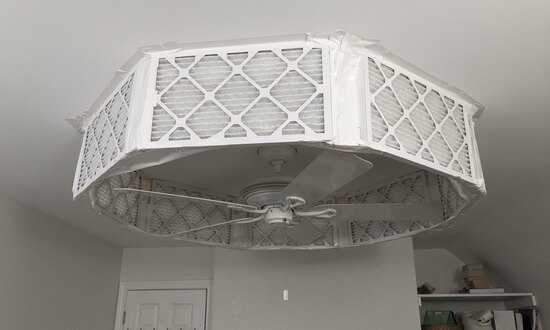Better Air Purifiers |
May 11th, 2025 |
| airquality, tech |
I've written a bunch about air purifiers over the past few years, and its frustrating how bad commercial market is.
The most glaring problem is the widespread use of HEPA filters. These are very effective filters that, unavoidably, offer significant resistance to air flow. HEPA is a great option for filtering air in single pass, such as with an outdoor air intake or a biosafety cabinet, but it's the wrong set of tradeoffs for cleaning the air that's already in the room. Air passing through a HEPA filter removes 99.97% of particles, but then it's mixed back in with the rest of the room air. If you can instead remove 99% of particles from 2% more air, or 90% from 15% more air, you're delivering more clean air. We should compare in-room purifiers on their Clean Air Delivery Rate (CADR), not whether the filters are HEPA.
Next is noise. Let's say you do know that CADR is what counts, and you go looking at purifiers. You've decided you need 250 CFM, and you get something that says it can do that. Except once it's set up in the room it's too noisy and you end up running it on low, getting just 75 CFM. Everywhere I go I see purifiers that are either set too low to achieve much or are just switched off. High CADR with low noise is critical.
Then consider filter replacement. There's a competitive market for standardized filters, where most HVAC systems use one of a small number of filter sizes. Air purifiers, though, just about always use their own custom filters. Some of this is the mistaken insistence on HEPA filters, but I suspect there's also a "cheap razors, expensive blades" component where manufacturers make their real money on consumables.
Then there's placement. Manufacturers put the buttons on the top and send air upwards, because they're designing them to sit on the floor. But a purifier on the floor takes up valuable space, is farther from where we inhale, and is at more risk of damage. Purifiers should be designed to use the space above our heads: on top of bookcases or shelves; mounted to walls or ceilings.
Finally, there's very little innovation. The top purifier on the Wirecutter is the Coway Airmega AP-1512HH, which has been their top pick since they first reviewed purifiers in 2017. It's not a bad purifier (I have several and they do what they're supposed to) but it's not close what's possible when maximizing CADR while minimizing noise and cost.
When I first got really into air purifiers three years ago, just before I decided to focus on a different aspect of pathogen control, I proposed a simple design:
This is a regular ceiling fan, with a ring of HVAC filters around it. The fan draws air through the filters, which capture particles through a mixture of impaction, interception, and diffusion. It cleans a lot of air with low noise, stays out of then way, and is built from standard parts that have healthy highly competitive markets. As far as I can tell, this design is still much better for many applications than anything on the market, and for bigger spaces purifiers built around a high-volume low-speed fan (ex) would be even better.
Making a nice version of this would look like two components.
A frame the attaches around an existing 52" fan to hold standard HVAC filters. You'd go through the drywall and attach to the joists, so you'd need to handle uneven joist spacing. The frame needs to get a good seal to the ceiling and around the filters to minimize leakage, the filters need be easily removed and replaced, and the whole assembly should be pretty. The frame can come in several user-assembled pieces each just a bit bigger than a filter, which allows it to be flat-packed.
A mesh cover to go around the outside of the frame, to make it look nicer since standard HVAC filters are not designed for aesthetics. It would also act as a pre-filter, and you could take it down to wash or vacuum, extending the life of the HVAC filters.
I really don't exactly need another project right now, but it's been three years since I first proposed this and the competition has barely improved. Anyone want to take this on? This would look like designing the frame, testing and validation, manufacturing, and marketing. I'd be very happy for someone else to commercialize this idea; it being out there is all the payment I'd be looking for.
Comment via: facebook, lesswrong, mastodon, bluesky, substack
